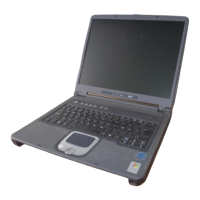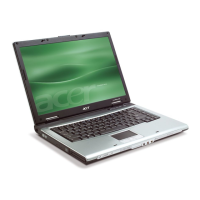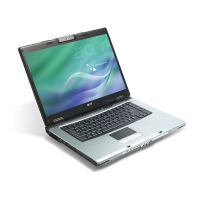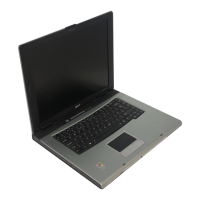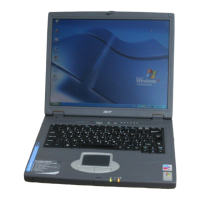
Do you have a question about the Acer TravelMate 2480 and is the answer not in the manual?
| Battery | 6-cell Li-Ion |
|---|---|
| RAM | 512 MB DDR2 |
| Storage | 80 GB HDD |
| Operating System | Windows XP Professional |
| Wireless | 802.11b/g |
| LAN | 10/100 Mbps Ethernet |
| Ports | 3 x USB 2.0 |
General safety precautions for product use and reference.
Instructions on how to safely turn off the device before cleaning.
Recommendations for safe listening practices to protect hearing.
Warnings regarding power cord safety, outlets, and overloading.
Safety warnings and guidelines for replacing the battery pack.
Precautions for wireless devices and RF exposure guidelines.
Safety advice for pacemakers, hearing aids, vehicle systems, and explosive environments.
Inability to make emergency calls and proper electronic device disposal.
Tips to prevent eyestrain, headaches, and musculoskeletal disorders.
Tips for optimizing posture, seating, and monitor placement.
Suggestions for eye care and display adjustments.
Tips on breaks, stretching, and general well-being.
Introduction to user guides, posters, and system manuals.
Instructions for protecting the computer from damage and elements.
Guidelines for maintaining the AC adapter and its cord.
Guidelines for caring for and disposing of the battery pack.
Procedures for cleaning the computer safely.
Introduction to the toolbar, its utilities, and password initialization.
Connecting to networks and managing location-based profiles.
Creating, switching, and editing power plans for battery optimization.
Using the utility to connect to projectors or external displays.
Utility for protecting files with passwords and encryption.
Utility to prevent unauthorized access to storage devices.
Creating backups and restoring the system or applications.
Inspecting hardware, setting BIOS passwords, and modifying boot options.
Centralized access to display, power, volume, and network settings.
Description of camera, screen, buttons, and indicators on the front.
Description of latch, power, battery indicators, speakers, and ports.
Description of display, ventilation, video, USB, IEEE, infrared, and card reader ports.
Description of optical drive, modem, and DC-in jack.
Description of security lock, USB, battery, ezDock, and Ethernet ports.
Description of memory compartment, cooling fan, and battery bay.
Information on supported OS and processor/chipset details.
Details on system memory capacity and hard disk drive options.
Specifications for the LCD screen and graphics hardware.
Details on power, battery, keyboard, and touchpad specifications.
Specifications for audio system, modem, LAN, WLAN, and Bluetooth.
Details on various ports and the 5-in-1 card reader.
Information on disk protection and BIOS passwords.
List of included software utilities and applications.
Information on optional accessories like docking stations and batteries.
Explanation of Caps Lock, Num Lock, HDD, Bluetooth, Power, and Battery indicators.
Description of easy-launch buttons and their default assignments.
How to use the touchpad for cursor movement and scrolling.
Explanation of Caps Lock, Num Lock, and Scroll Lock keys.
Explanation of the Windows key and its shortcuts.
List of hotkeys for accessing system functions like brightness and volume.
How to type the Euro and US dollar symbols.
Methods to eject the CD/DVD drive tray.
Using hotkeys to control speaker volume.
Package contents, layout, and indicators of the VoIP phone.
Explanation of the status lights for Bluetooth and charging.
Step-by-step instructions for charging the phone.
Steps to connect and pair the phone via Bluetooth.
How to use the phone in different modes for calls.
Enabling and configuring dual displays using Acer GridVista.
How to configure the function of easy-launch buttons.
Steps to check for viruses and schedule scans.
Troubleshooting for power, screen, and image display problems.
Solutions for no audio, unresponsive keyboard, and infrared port issues.
Configuring communication software for modem use.
Steps for system recovery without recovery CDs.
Information about the ITW program and service.
Steps to disconnect accessories and prepare for transport.
Features of the battery and the initial conditioning process.
Recommendations to prolong the battery's effective lifespan.
Step-by-step guide for battery pack installation and removal.
Advice on extending battery life through usage patterns.
Guidelines for protecting the computer during travel.
Recommended actions when the battery-low warning appears.
Setting and importance of Supervisor, User, and Boot passwords.
Steps for entering passwords and warnings about lockout.
Description of ports for connecting devices.
Using the modem and important warnings.
Connecting to an Ethernet-based network.
Wireless data transfer using the FIR port.
Using the high-speed USB 2.0 port.
Connecting IEEE 1394-compatible devices like cameras.
Using the PC Card slot and inserting/ejecting cards.
Step-by-step guide for installing memory modules.
Description and activation of the BIOS utility.
How to configure the boot order in the BIOS.
Steps to enable disk-to-disk recovery in BIOS.
How to set passwords for booting the system.
How to play DVDs and manage region codes.
Procedures for creating full or incremental backups.
How to burn backup images to CD or DVD.
Steps to restore the system from various backup points.
List of error messages and their solutions.
FCC compliance statements and measures to correct interference.
Guidelines for peripheral devices and shielded cables.
Compliance declarations for Canada and EU countries.
FCC rules and telephone company notification for modems.
Approval for telephone network connection and applicable countries.
Safety requirement for connecting headsets in Australia.
Telepermit conditions, speed limitations, and dialing types.
CLASS 1 LASER PRODUCT statement and radiation cautions.
Statement on LCD pixels and Macrovision copyright protection.
Compliance with radio frequency and safety standards.
EU directives and harmonized standards for radio devices.
Caution for maintaining separation distance from antennas.
Conditions for operation in 2.4 GHz and 5 GHz bands.
Information about the product and the responsible party.
Compliance with EMC and Low Voltage Directives.
Specifications for viewing distance, angles, illuminance, and pixels.
How to play DVDs and manage region codes.
